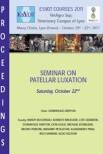Objective: The aim of this study was to determine the prevalence of contralateral cranial cruciate ligament rupture (CCLR) in dogs 8 years of age or older, weighing more than or equal to 15 kg at the time of first-side CCLR and to assess associated risks.
Study design: It is a cross-sectional retrospective study of 831 client-owned dogs METHODS: Medical records of dogs weighing more than or equal to 15 kgs that were more than or equal to 8 years of age at the time of first CCLR diagnosis were reviewed. Data collected included weight, sex, pre-operative tibial plateau angle, co-morbidities, time between diagnosis of first CCLR and diagnosis of contralateral CCLR. Multivariate logistic regression analysis was used to estimate odds ratio. A median follow-up period of over 112.7 months (25th/75th quartiles 75.4/157.7 months) from first CCLR diagnosis was allotted.
Results: Eight-hundred thirty-one dogs were identified and included. About 19.1% (159/831 dogs, 95% confidence interval: 16.6-22.0%) of dogs that experience a first-side CCLR at 8 years of age or older will rupture the contralateral side, a median of 12.9 months (25th/75th quartiles 6.5/24.3 months) later. Age (p = 0.003) and breed, Golden Retrievers (p = 0.028) and Labrador Retrievers (p = 0.007), were factors significantly associated with contralateral CCLR.
Clinical relevance: The prevalence of contralateral CCLR in medium-to-large breed dogs more than or equal to 8 years of age old is less than previously reported and the risk decreases as they age. This important information will help guide owners when deciding to pursue surgical stifle stabilization following CCLR in older dogs.









